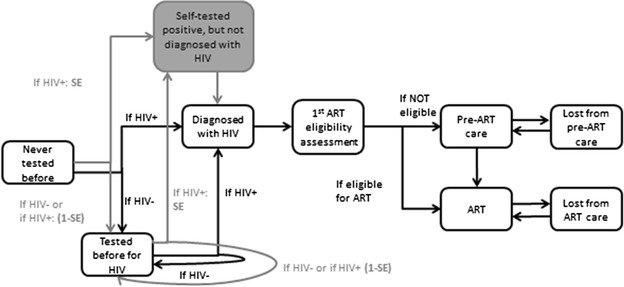Fig. 1.

Example of parameterization of self-testing in a mathematical model (Synthesis model [57, 58]). Illustration of features of a model incorporating HIVST—the section of the graph in grey only applies if HIVST is introduced. Features such as the level of sexual behaviour and whether the person is truly HIV infected would be included in such a model but are left cut here for the purposes of simplification. People can be tested for the first time using a provider delivered HTC at a different rate (in the model this rate may depend on sexual behaviour, age, gender, presence of symptoms and other factors). If HIV negative they respectively move or remain in the group of those who tested before for HIV, while if HIV positive are considered diagnosed with HIV. At this stage they experience a certain rate of having the 1st ART eligibility assessment, and once this is completed of being enrolled into pre-ART care, if not eligible for ART, or to be initiated on ART if eligible. Whether in pre-ART care or on ART, they can be lost from care and return back into care. If a person with HIV is self-tested for HIV, they have a chance equal to the sensitivity of the self-test (SE) that the result of the test is positive. If the test result is positive the person is not considered diagnosed with HIV, but there is a certain rate with which they will have a confirmatory provider-delivered HTC. For simplicity of illustration in this graph we have assumed that the test provider by a trained person is 100 % accurate and that the specificity of the self-test is 1. If a person has a self-test and either is not infected with HIV or, if HIV+, with a probability of (1−SE) the person would remain in the group of those who tested before for HIV. People with HIV diagnosed via self testing positive then follow the same path as those who tested for HIV using provider delivered HTC, although the rate at which they have the 1st ART eligibility assessment could differ. At these different stages the risk of morbidity and mortality and of infecting other people [not illustrated in the Figure) varies In the Synthesis model the risk of morbidity and mortality depends on age and gender and for people HIV-positive as well on CM-count, viral load, ART and PCP prophylaxis; while the risk of transmission mainly on the HIV-RNA level of the partner the person has condom-less sex with (Further details are available in [53, 54]).
